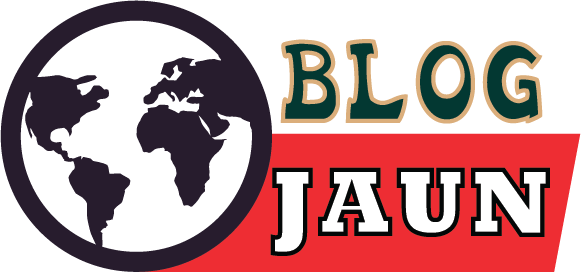As I battled along brambly footpaths and unmade suburban roads, chased out of Tirana by street dogs, I had my doubts about this trip. I’d arrived with the sinking realisation that I’d forgotten to pack my multitool and had to scour Tirana’s bike shops to find one, and then my route failed to download on my Garmin. It was early afternoon before I’d picked up the right road and found a cafe with a satisfying view back to the capital. When the waiter said my proposed route to Elbasan was “not possible”, I panicked, only to realise he just meant it would be easier on a motorbike. The road would turn out to be not only possible but quiet, smooth and scenic. The only hazard was crossing tortoises, varying in size from half-walnut to half-football.
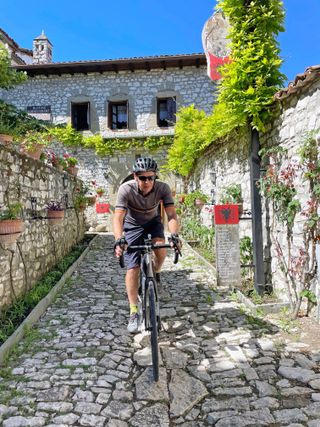
(Image credit: Simon Thomas)
Since retiring from work in 2021, I’ve ridden across Scotland, Spain and France. For my next trip, I wanted to explore further afield. Stumbling upon a UNESCO heritage route in southern Albania, I was intrigued, but all I knew about Albania was that it was a mountainous country in the Balkans, had a king called Zog and had been closed to the rest of the world from 1945-1990 under the communist regime of Enver Hoxha. As I began plotting my route, I was drawn in by the irresistible-looking Ohrid and Prespa lakes and the town of Ohrid in North Macedonia. Adjusting accordingly, I planned to start and finish in Tirana, riding 50- 100km per day over 17 days in June through south-eastern North Macedonia and southern Albania. On paper at least, it looked spectacular.
Between Elbasan and Lake Ohrid, my Garmin told me to leave the SH3 onto a concrete road, which descended steeply and crossed the River Shkumbin. It next wanted to send me up an unrideably steep track, so I ignored it and continued. I’m sure I’m not alone in an irrational reluctance to retrace my steps, even when it’s clearly the sensible thing to do. Convincing myself on the basis of nothing at all that the road must become rideable soon, I sweated and stumbled up the rock-strewn track under the hot sun.
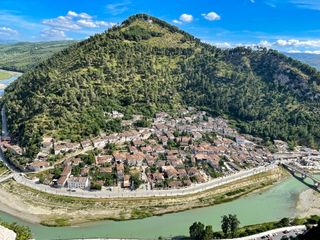
Berat, viewed from the citadel
(Image credit: Simon Thomas)
After a few kilometres I reached a junction with a sign for Via Egnatia. Fantastic, I thought, the Romans knew how to build a road, it must get better now. Builtin the second century BC, linking Rome and Constantinople, the road may have been impressive back then, but now it was virtually unusable except by tortoises, lizards and snakes. A man appeared from a house with pity in his eyes. “Pogradec?” I said, gesturing vaguely towards Constantinople. He somewhat dubiously agreed and offered to fill my bidons. I was relieved to rejoin the smooth tarmac of the SH3 as it wound its way eastwards through hills to Lake Ohrid.
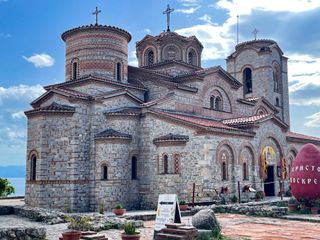
Ohrid’s known for its churches
(Image credit: Simon Thomas)
On the steep north-eastern shore of Lake Ohrid, I passed by idyllic spots for swimming, and arriving in Ohrid’s old town I found plentiful bars and restaurants along the narrow cobbled streets. Incredibly, Ohrid boasts as many churches as the year has days, though my tired legs were protesting after just three, the last being the 11th-century St. Sophia, which has been both a mosque, under Ottoman rule, and an Orthodox church.
Small-town largesse
The road from Lake Ohrid to Lake Prespa through the Galicica National Park was a delight, climbing 730m to 1,590m over 16km at a steady 5%. The forested ascent afforded occasional views to Lake Ohrid, and the road surface was excellent with almost no traffic. Above 1,400m, I was in cool misty rain, and there was nothing to indicate I’d reached the pass other than a swampy watershed and a cool breeze from the east. Finally descending, I emerged from the mist through trees towards the shores of Lake Prespa.
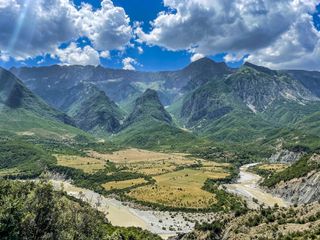
(Image credit: Simon Thomas)
On the east side of the lake and at the edge of the Baba Mountains, my accommodation above the village of Brajčino was in a fabulous setting. Having settled in, I walked to a bar on the village square, where after one beer another appeared on the table. A man on the next table said: “The first you pay for, the second is on the house” – now that’s hospitality! I returned to a superb dinner of salads, roasted stuffed peppers and leek tart with “homemade” red wine, and was feeling a little woozy by the time I headed to bed. Despite the slight hangover, I didn’t mind at all being woken by a nightingale singing outside my bedroom window at 4am.
The latest race content, interviews, features, reviews and expert buying guides, direct to your inbox!
Back on the west shore of Lake Prespa, I headed south on the undulating SH79 accompanied by two Swiss cyclists, both conveniently called Bruno, whom I’d met at a coffee stop waiting for the rain to ease. We headed through sparse forests, then, after the Brunos left me, I continued along a glorious switchbacked descent to the plain, and the city of Korça, which gives its name to Albania’s popular beer. I avoided the busy A86 into Korça by taking sometimes gravelly roads through villages and fields to the north of the main road. Sheep, goats and cattle bells tinkled and horses pulled carts of hay and fruit.
Tipsy tipping
Voskopoja was once the largest city in the Balkans, which was diffi cult to imagine as it’s now a quiet agricultural town and tourist attraction. The priest showed me the beautiful church of St Nicholas and its crumbling frescos, after which I ate a hearty dinner of spit-roast lamb, butter beans and salad at the Ambassador restaurant. Confused by switching between euros and lek, and possibly owing to the influence of the very drinkable local red wine, I mistakenly left 2,000 instead of 200 lek for service. The gracious owner ran down the road after me to return it.
Thr gracious owner ran down the road after me to return my tip
You seldom ride far in Albania without passing one of the concrete mushroom bunkers constructed under Hoxha to fortify the country against invasion. Some are used for storage, some house animals and many are painted and graffitied or simply abandoned. They still seem to be watching. The drama of my surroundings intensified on day seven when the road began to weave its way through spectacular mountains, and lightning streaks split the slate-grey sky, thunder rattling the peaks. I arrived at my accommodation, a comfortable cabin at Farma Sotira, just as torrential rain began to fall. It was near Përmeti that a jackal briefly appeared on the road ahead, caught my eye for a second and darted into the undergrowth.
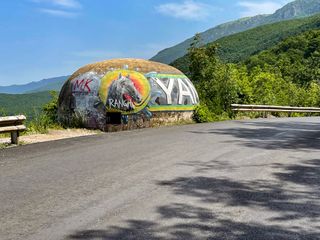
(Image credit: Simon Thomas)
My accommodation in Përmeti, named the Honey-House, overlooked the River Vjosa, which was high and running fast with dirty-white runoff from the previous day’s storms in the Greek mountains. My host Kastrioti presented me with a glass of raki the moment I was off my bike. At dinner he explained the name: Kastrioti served excellent honey from his bees in the mountains.
The run into Gjirokastra from the north-west was busy and, like all of the larger towns, featured scruffy kilometres of service stations, building materials stores, furniture shops and cafes. Even here, Albanian drivers were considerate, and I didn’t have any traffic-related incidents, though in towns I never assumed I had the right of way. The road surfaces were mostly good, and many had a narrow lane on the right used by pedestrians, bicycles, horse-and-carts and mules.
At halfway through my tour, I reached Gjirokastra, one of Albania’s main tourist attractions. With mosques, churches, museums, historic houses and plenty of bars and restaurants, it would be a good place to take a rest day. The majestic hill-top castle houses museums with informative history of the city and the country. Having exhausted myself sightseeing, I rested in the evening sun as the call to prayer drifted from the mosques across the old bazaar.
Saranda sojourn
On day 10, I arrived at the port of Saranda. My first view of the Ionian Sea was framed by unsightly multi-storey hotels, and I questioned my decision to spend two nights here. But after experiencing the hospitality at Deni’s Hotel, a swim and a beer in a seafront bar, my mood improved remarkably. Deni was a lovely host, too, locking my bike in his house and recommending a superb local fish taverna.
Leaving my luggage with Deni, I cycled 18km to Butrint along the west side of the lagoon. The ancient city of Butrint – mainly Roman but with Hellenistic, Byzantine, Venetian and Ottoman contributions – was enchanting, and three hours flew by. To return to Saranda, I took the ferry south across the channel separating the lagoon from the sea then rode across the traffi c-free flats.
On both mornings in Saranda, Deni and I sat together on the steps of his hotel in the morning sun enjoying an espresso and a roll-up. He spoke a little English, some Italian and Russian learned “under communism”. As I departed, he put his hand on my shoulder, shook my hand and said: “Goodbye Simon, you strong man… you good man.” He obviously hadn’t seen my Strava stats.
I rode away from Deni feeling more positive about Saranda, reflecting on how the most poignant and memorable encounters often occur in the least promising places. The coast road north of Saranda wound through the hills, dipping and rising between sea level and 300m. While much of the coast has been developed with hotels, obscuring beaches with rows of loungers and parasols, the road was great cycling with relatively light traffic. As I progressed, the villages grew less developed, making for a more interesting ride. Within easy access of the road around Ali Pasha’s castle and Porto Palermo, the numerous swimming spots were hard to resist.
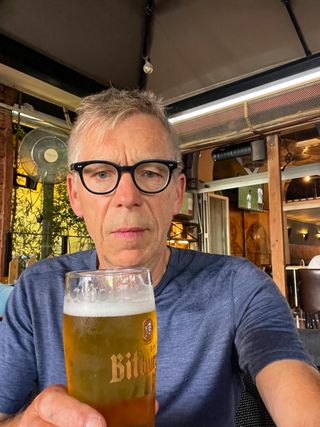
Simon raises a toast as he enjoys a a post-tour beer
(Image credit: Simon Thomas)
The climb to Llogara National Park on day 13 started from sea level, rose to 370m, dropped to 150m after Dhërmiu and climbed to 1,030m over 16km. Looking south, the coast appeared a building site, whereas the view north was of lovely, scrubby Mediterranean mountains. Here I found one of my favourite stays of the trip, Hotel Alberti. Set back from the road in trees with a calm shady terrace, it was charmingly dishevelled and friendly. Swallows nested in the eaves and bats hunted insects by dusk.
My plan for a downhill, pedalling-free 14th day of riding, also my birthday, was disrupted by a northerly headwind. The road around Orikumi was busy and gravelly and the section to Vlora is 20km of almost uninterrupted hotels and loungers, today depressingly deserted in the drizzle. Leaving the coast along quiet roads through rolling farmland, I followed EuroVelo 8, then turned east on gravel and mud roads through fields, passing olive and fruit trees and even an oil field. I was relieved to return to tarmac and find a small cafe, occupied by the owner and one customer who despite language barriers was interested to find out what I was doing. When I went to pay, I was waved away – the inquisitive customer had paid for my coffee and beer.
The inquisitive customer had paid for my coffee and beer
In Berat, Hotel Klea is located in the hill-top citadel. The last few hundred metres consisted of steep, deathly slippery cobbles. The citadel has no modern buildings and was tranquil Clockwise from L: riding rural roads; a watering stop; a Hoxha bunker and beautiful with a handful of souvenir shops, cafes and hotels. If you are partial to an icon, the museum, housed in the Church of the Formation of St Mary is worth a visit. Hotel Klea was my top stay: a small, family hotel run by Xenophon, the owners’ son, who was a charming and attentive host. The food was excellent and my room had mountain views.
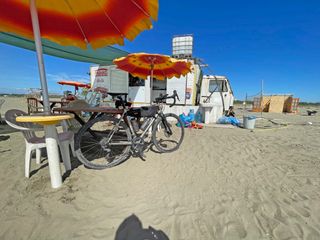
Fast Food Franko was the ideal stop for a bird watching bikepacker
(Image credit: Simon Thomas)
The penultimate day was an easy ride to Divjaka. After checking in, I rode on to Karavasta Lagoon Nature Reserve and adjacent Divjaka Beach. On the windswept sands, I found Fast Food Franko, a rusty truck serving burgers and beers alongside parasols and loungers with families sunbathing and playing. The reserve consists of pine woods and bushes, with a viewing platform on the idyllic lagoon where I saw flamingos, pelicans, and bee eaters.
Upon my return to Tirana, my host at La Voglia greeted me like an old friend, had my bike box ready and my taxi to the airport booked. After packing, I walked round Skanderbeg Square and settled for a few beers before excellent food at Oda restaurant with entertainment from a folk band. Walking back through the old market, I wished I had another night to explore the capital.
Albania is a beguiling country of contrasts. I never felt uneasy in cities at night or in remote areas. The people, while not exactly effusive, were kind and hospitable. Most speak some English, and those who did not were always patient, reacting warmly and with humour at my attempts to speak their language. Though it may not have the traffic-free country lanes of France or the hilltop villages of Tuscany, Albania has spectacular scenery, fascinating monuments and antiquities and, in June, a suitable climate (not too hot) and nowhere too crowded. It was an immensely enjoyable, interesting and straightforward country for a road tour. I would happily return, probably to explore the northern half of the country, and likewise North Macedonia, having spent only three nights there. I left determined to return and see more.
Key information
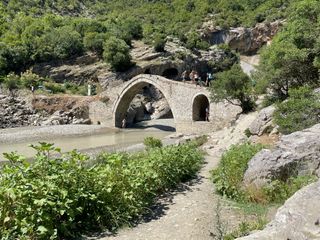
(Image credit: Simon Thomas)
How to get there
I flew with Ryanair from Stansted to Tirana, which cost £59 return, plus £120 for my bike. This return flight emits 0.69 tonnes of CO2. For ways to offset, go to www. carbonfootprint.com
Where to stay
La Voglia hotel in central Tirana arranged airport taxis (€15 each way) and stored my bike box for 17 days for free. Accommodation in Albania and North Macedonia is cheap, with ensuite rooms costing €30-45. Booking ahead wasn’t crucial; everywhere provided bike storage. l Eating and drinking On the coast, there is excellent seafood; Turkish, Greek and Italian restaurants abound. Generally I paid €20-30 for dinner including drinks. Beers cost €1.50-3.50 for 500ml. House red wines were good and cheap at €2-3 a glass.
Fauna and flora
Birdlife is exceptional: nightingales, fl amingos, hoopoes, bee-eaters, golden orioles, shrikes, peregrines, even golden eagles. Reptiles too: I almost ran over the biggest snake I’d ever seen in the wild.
Currency and communications
The currency is Albanian lek but euros and card payments are widely accepted. There are plenty of ATMs. l What I rode My Enigma Etape titanium road bike – set up with 50/34 front, 11-34t rear, 30mm tubeless tyres and recessed cleats – served me brilliantly once again.
This feature originally appeared in Cycling Weekly magazine. Subscribe now and never miss an issue.
